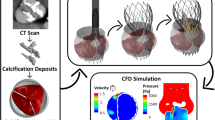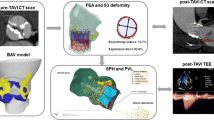Abstract
Transcatheter aortic valve replacement (TAVR) in patients with bicuspid aortic valve disease (BAV) has potential risks of under expansion and non-circularity which may compromise long-term durability. This study aims to investigate calcium fracture and balloon over expansion in balloon-expandable TAVs on the stent deformation with the aid of simulation. BAV patients treated with the SAPIEN 3 Ultra with pre- and post-TAVR CTs were analyzed (n = 8). Simulations of the stent deployment were performed (1) with baseline simulation allowing calcium fracture, (2) without allowable calcium fracture and (3) with balloon over expansion (1 mm larger diameter). When compared to post CT, baseline simulations had minimal error in expansion (2.5% waist difference) and circularity (3.0% waist aspect ratio difference). When compared to baseline, calcium fracture had insignificant impact on the expansion (− 0.5% average waist difference) and circularity (− 1.6% average waist aspect ratio difference). Over expansion had significantly larger expansion compared to baseline (15.4% average waist difference) but had insignificant impact on the circularity (− 0.5% waist aspect ratio difference). We conclude that stent deformation can be predicted with minimal error, calcium fracture has small differences on the final stent deformation except in extreme calcified cases, and balloon over expansion expands the waist closer to nominal values.







Similar content being viewed by others
Abbreviations
- AS:
-
Aortic stenosis
- BAV:
-
Bicuspid aortic valve
- CAVD:
-
Calcific aortic valve disease
- CT:
-
Computed tomography
- HALT:
-
Hypo-attenuated leaflet thickening
- TAVR:
-
Transcatheter aortic valve replacement
- THV:
-
Transcatheter heart valve
- BE:
-
Balloon-expandable
References
Siu, S. C., and C. K. Silversides. Bicuspid aortic valve disease. J Am Coll Cardiol. 55:2789–2800, 2010.
Yutzey, K. E., L. L. Demer, S. C. Body, et al. Calcific aortic valve disease: a consensus summary from the Alliance of Investigators on Calcific Aortic Valve Disease. Arterioscler. Thromb. Vasc. Biol. 34:2387–2393, 2014.
Leon, M. B., M. J. Mack, R. T. Hahn, et al. Outcomes 2 years after transcatheter aortic valve replacement in patients at low surgical risk. J Am. Coll. Cardiol. 77:1149–1161, 2021.
Kim, W.-K., C. Liebetrau, U. Fischer-Rasokat, et al. Challenges of recognizing bicuspid aortic valve in elderly patients undergoing TAVR. Int. J. Cardiovasc. Imaging. 36:251–256, 2020.
Edwards Lifesciences Lsasuthv. Approval for modifying the labeling to remove the precaution regarding patients with a congenital bicuspid aortic valve. Administration FaD, editor, 2020.
Medtronic Corevalve LLC Medtronic CoreValve Evolut R System MCEPS, and Medtronic Evolut PRO+ System. Approval for modifying a precaution in the labeling regarding patients with a congenital bicuspid aortic valve. Administration FaD, editor, 2020.
Fukui, M., V. N. Bapat, S. Garcia, et al. Deformation of transcatheter aortic valve prostheses: implications for hypoattenuating leaflet thickening and clinical outcomes. Circulation. 146:480–493, 2022.
Nakajima, A., T. Naganuma, H. Yuki, et al. The impact of aortic valvular calcium on transcatheter heart valve distortion. J. Interv. Cardiol. 2021:8829906, 2021.
Rashid, H. N., M. Michail, J. Ramnarain, et al. The impact of hypo-attenuated leaflet thickening on haemodynamic valve deterioration following transcatheter aortic valve replacement. J. Cardiovasc. Comput. Tomogr. 16:168–173, 2022.
Gunning, P. S., N. Saikrishnan, L. M. McNamara, and A. P. Yoganathan. An in vitro evaluation of the impact of eccentric deployment on transcatheter aortic valve hemodynamics. Ann. Biomed. Eng. 42:1195–1206, 2014.
Khodaee, F., M. Barakat, M. Abbasi, D. Dvir, and A. N. Azadani. Incomplete expansion of transcatheter aortic valves is associated with propensity for valve thrombosis. Interact. Cardiovasc. Thorac. Surg. 30:39–46, 2020.
Yeats, B. B., P. K. Yadav, L. P. Dasi, and V. H. Thourani. Treatment of bicuspid aortic valve stenosis with TAVR: filling knowledge gaps towards reducing complications. Curr. Cardiol. Rep. 24(1):33–41, 2022.
Yeats, B. B., P. K. Yadav, L. P. Dasi, and V. H. Thourani. Transcatheter aortic valve replacement for bicuspid aortic valve disease: does conventional surgery have a future? Ann. Cardiothorac. Surg. 11(4):389–401, 2022.
Anam, S. B., B. J. Kovarovic, R. P. Ghosh, et al. Assessment of paravalvular leak severity and thrombogenic potential in transcatheter bicuspid aortic valve replacements using patient-specific computational modeling. J. Cardiovasc. Transl. Res. 15:834–844, 2022.
Lavon, K., G. Marom, M. Bianchi, et al. Biomechanical modeling of transcatheter aortic valve replacement in a stenotic bicuspid aortic valve: deployments and paravalvular leakage. Med. Biol. Eng. Comput. 57:2129–2143, 2019.
Dowling, C., A. M. Bavo, N. El Faquir, et al. Patient-specific computer simulation of transcatheter aortic valve replacement in bicuspid aortic valve morphology. Circ. Cardiovasc. Imaging.12:e009178, 2019.
Morany, A., K. Lavon, R. Halevi, et al. Fragmentation of different calcification growth patterns in bicuspid valves during balloon valvuloplasty procedure. Ann. Biomed. Eng. 51(5):1014–1027, 2022.
Mathur, M., J. M. McCabe, G. Aldea, J. Pal, C. W. J. C. Don, and C. Interventions. Overexpansion of the 29 mm SAPIEN 3 transcatheter heart valve in patients with large aortic annuli (area > 683 mm2): a case series. Catheter Cardiovasc. Interv. 91:1149–1156, 2018.
Sathananthan, J., S. Sellers, A. Barlow, et al. Overexpansion of the SAPIEN 3 transcatheter heart valve: an ex vivo bench study. JACC Cardiovasc. Interv. 11:1696–1705, 2018.
Bianchi, M., G. Marom, R. P. Ghosh, et al. Patient-specific simulation of transcatheter aortic valve replacement: impact of deployment options on paravalvular leakage. Biomech. Model. Mechanobiol. 18:435–451, 2019.
Jilaihawi, H., M. Chen, J. Webb, et al. A bicuspid aortic valve imaging classification for the TAVR era. JACC Cardiovasc. Imaging. 9:1145–1158, 2016.
Martin, C., and W. Sun. Biomechanical characterization of aortic valve tissue in humans and common animal models. J. Biomed. Mater. Res. 100:1591–1599, 2012.
Reza, S., M. Bianchi, B. Kovarovic, et al. A computational framework for post-TAVR cardiac conduction abnormality (CCA) risk assessment in patient-specific anatomy. Artif. Organs. 46(7):1306–1317, 2022.
Holzapfel, G. A., G. Sommer, and P. Regitnig. Anisotropic mechanical properties of tissue components in human atherosclerotic plaques. J. Biomech. Eng. 126:657–665, 2004.
Tzamtzis, S., J. Viquerat, J. Yap, M. Mullen, and G. Burriesci. Numerical analysis of the radial force produced by the Medtronic-CoreValve and Edwards-SAPIEN after transcatheter aortic valve implantation (TAVI). Med. Eng. Phys. 35:125–130, 2013.
Wang, Q. Patient-Specific Finite Element Modeling of Biomechanical Interaction in Transcatheter Aortic Valve Implantation. Atlanta: Georgia Institute of Technology, 2015.
Aggarwal, A., G. Ferrari, E. Joyce, et al. Architectural trends in the human normal and bicuspid aortic valve leaflet and its relevance to valve disease. Ann. Biomed. Eng. 42:986–998, 2014.
Martin, G. P., M. Sperrin, R. Bagur, et al. Pre-implantation balloon aortic valvuloplasty and clinical outcomes following transcatheter aortic valve implantation: a propensity score analysis of the UK registry. J. Am. Heart Assoc.6:e004695, 2017.
Acknowledgments
We acknowledge Dr. Ajit Yoganathan as co-advisor to Breandan Yeats overseeing conflict of interest, serving on the dissertation committee, and providing advice on the scientific direction and interpretation of results.
Author information
Authors and Affiliations
Corresponding author
Ethics declarations
Conflict of interest
Breandan B. Yeats has a patent pending as co-inventor of patents related to computational predictive modeling of heart valves and is a stakeholder in DASI Simulations. Sri Krishna Sivakumar has a patent pending as co-inventor of patents related to computational predictive modeling of heart valves. Pradeep K. Yadav is a consultant for Edwards Lifesciences, Medtronic Inc, Abbott Vascular, Shockwave Medical. Vinod H. Thourani is a consultant or research with Abbott Vascular, Boston Scientific, Cryolife, Edwards Lifesciences, Medtronic Corp, and Shockwave Medical and stakeholder in Dasi Simulations. Stephanie Sellers is a consultant to Edwards, Anteris and Medtronic and receives research funding from Edwards, Medtronic, Heartflow, and Michael Smith Health Research BC. Janarthanan Sathananthan is a consultant to Edwards, Boston Scientific, Anteris and Medtronic and receives research funding from Edwards and Medtronic. Lakshmi P. Dasi is a stakeholder in DASI Simulations, and has a patent pending as co-inventor of patents related to computational predictive modeling of heart valves. Other authors report no conflicts of interest.
Additional information
Associate Editor Arash Kheradvar oversaw the review of this article.
Publisher's Note
Springer Nature remains neutral with regard to jurisdictional claims in published maps and institutional affiliations.
Supplementary Information
Below is the link to the electronic supplementary material.
Rights and permissions
Springer Nature or its licensor (e.g. a society or other partner) holds exclusive rights to this article under a publishing agreement with the author(s) or other rightsholder(s); author self-archiving of the accepted manuscript version of this article is solely governed by the terms of such publishing agreement and applicable law.
About this article
Cite this article
Yeats, B.B., Sivakumar, S.K., Samaee, M. et al. Calcium Fracture and Device Over Expansion in Transcatheter Aortic Valve Replacement for Bicuspid Aortic Valves. Ann Biomed Eng 51, 2172–2181 (2023). https://doi.org/10.1007/s10439-023-03246-6
Received:
Accepted:
Published:
Issue Date:
DOI: https://doi.org/10.1007/s10439-023-03246-6




